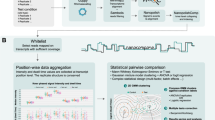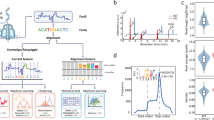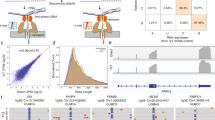Abstract
RNA modifications, such as N6-methyladenosine (m6A), modulate functions of cellular RNA species. However, quantifying differences in RNA modifications has been challenging. Here we develop a computational method, xPore, to identify differential RNA modifications from nanopore direct RNA sequencing (RNA-seq) data. We evaluate our method on transcriptome-wide m6A profiling data, demonstrating that xPore identifies positions of m6A sites at single-base resolution, estimates the fraction of modified RNA species in the cell and quantifies the differential modification rate across conditions. We apply xPore to direct RNA-seq data from six cell lines and multiple myeloma patient samples without a matched control sample and find that many m6A sites are preserved across cell types, whereas a subset exhibit significant differences in their modification rates. Our results show that RNA modifications can be identified from direct RNA-seq data with high accuracy, enabling analysis of differential modifications and expression from a single high-throughput experiment.
This is a preview of subscription content, access via your institution
Access options
Access Nature and 54 other Nature Portfolio journals
Get Nature+, our best-value online-access subscription
$29.99 / 30 days
cancel any time
Subscribe to this journal
Receive 12 print issues and online access
$209.00 per year
only $17.42 per issue
Buy this article
- Purchase on Springer Link
- Instant access to full article PDF
Prices may be subject to local taxes which are calculated during checkout






Similar content being viewed by others
Data availability
All data generated in this study are publicly available through the ENA (PRJEB40872). Here we used the following samples: HEK293T METTL3-KO cells (three replicates); HEK293T WT cells (three replicates); HEK293T METTL3-KD cells (three replicates); HEK293T KD control WT cells (three replicates); HEK293T WT–KO mixture, 100% modified (three replicates); HEK293T WT–KO mixture, 75% modified (four replicates); HEK293T WT–KO mixture, 50% modified (four replicates); HEK293T WT–KO mixture, 20% modified (four replicates); HEK293T WT–KO mixture, 0% modified (three replicates); multiple myeloma patient samples (three patient samples).
In addition, we used direct RNA-seq data from the SG-NEx project33, which are available at https://github.com/GoekeLab/sg-nex-data and https://www.ebi.ac.uk/ena/browser/view/PRJEB44348.
Preprocessed files for all samples are available at https://doi.org/10.5281/zenodo.4604945 for SG-NEx data and https://doi.org/10.5281/zenodo.4587661 for the other samples, which can be directly used to identify differential RNA modifications with xPore. The list of all samples can be found in Supplementary Data 7.
Samples from the three patients with myeloma were obtained after informed consent. The use of these samples for research was approved by the Domain Specific Review Board in Singapore.
Code availability
Our implementation in Python is available at https://github.com/GoekeLab/xpore. xPore’s documentation is available at https://xpore.readthedocs.io.
References
Zheng, G. et al. ALKBH5 is a mammalian RNA demethylase that impacts RNA metabolism and mouse fertility. Mol. Cell 49, 18–29 (2013).
Wang, Y. et al. N6-methyladenosine modification destabilizes developmental regulators in embryonic stem cells. Nat. Cell Biol. 16, 191–198 (2014).
Zhao, X. et al. FTO-dependent demethylation of N6-methyladenosine regulates mRNA splicing and is required for adipogenesis. Cell Res. 24, 1403–1419 (2014).
Geula, S. et al. Stem cells. m6A mRNA methylation facilitates resolution of naïve pluripotency toward differentiation. Science 347, 1002–1006 (2015).
Chen, T. et al. m6A RNA methylation is regulated by microRNAs and promotes reprogramming to pluripotency. Cell Stem Cell 16, 289–301 (2015).
Xu, K. et al. Mettl3-mediated m6A regulates spermatogonial differentiation and meiosis initiation. Cell Res. 27, 1100–1114 (2017).
Mathiyalagan, P. et al. FTO-dependent N6-methyladenosine regulates cardiac function during remodeling and repair. Circulation 139, 518–532 (2019).
Li, Z. et al. FTO plays an oncogenic role in acute myeloid leukemia as a N6-methyladenosine RNA demethylase. Cancer Cell 31, 127–141 (2017).
Su, R. et al. R-2HG exhibits anti-tumor activity by targeting FTO/mA/MYC/CEBPA signaling. Cell 172, 90–105 (2018).
Deng, X. et al. RNA N6-methyladenosine modification in cancers: current status and perspectives. Cell Res. 28, 507–517 (2018).
Wang, X. et al. N6-methyladenosine-dependent regulation of messenger RNA stability. Nature 505, 117–120 (2014).
Meyer, K. D. et al. 5′ UTR m6A promotes cap-independent translation. Cell 163, 999–1010 (2015).
Alarcón, C. R., Lee, H., Goodarzi, H., Halberg, N. & Tavazoie, S. F. N6-methyladenosine marks primary microRNAs for processing. Nature 519, 482–485 (2015).
Alarcón, C. R. et al. HNRNPA2B1 is a mediator of m6A-dependent nuclear RNA processing events. Cell 162, 1299–1308 (2015).
Koh, C. W. Q., Goh, Y. T. & Goh, W. S. S. Atlas of quantitative single-base-resolution N6-methyl-adenine methylomes. Nat. Commun. 10, 5636 (2019).
Zaccara, S. & Jaffrey, S. R. A unified model for the function of YTHDF proteins in regulating m6A-modified mRNA. Cell 181, 1582–1595 (2020).
Goh, Y. T., Koh, C. W. Q., Sim, D. Y., Roca, X. & Goh, W. S. S. METTL4 catalyzes m6Am methylation in U2 snRNA to regulate pre-mRNA splicing. Nucleic Acids Res. 48, 9250–9261 (2020).
Yankova, E. et al. Small-molecule inhibition of METTL3 as a strategy against myeloid leukaemia. Nature 593, 597–601 (2021).
Zaccara, S., Ries, R. J. & Jaffrey, S. R. Reading, writing and erasing mRNA methylation. Nat. Rev. Mol. Cell Biol. 20, 608–624 (2019).
Linder, B. et al. Single-nucleotide-resolution mapping of m6A and m6Am throughout the transcriptome. Nat. Methods 12, 767–772 (2015).
Meyer, K. D. DART-seq: an antibody-free method for global m6A detection. Nat. Methods 16, 1275–1280 (2019).
Garalde, D. R. et al. Highly parallel direct RNA sequencing on an array of nanopores. Nat. Methods 15, 201–206 (2018).
Stoiber, M. et al. De novo identification of DNA modifications enabled by genome-guided nanopore signal processing. Preprint at bioRxiv https://doi.org/10.1101/094672 (2017).
Leger, A. et al. RNA modifications detection by comparative Nanopore direct RNA sequencing. Preprint at bioRxiv https://doi.org/10.1101/843136 (2019).
Parker, M. T. et al. Nanopore direct RNA sequencing maps the complexity of Arabidopsis mRNA processing and m6A modification. eLife 9, e49658 (2020).
Liu, H. et al. Accurate detection of m6A RNA modifications in native RNA sequences. Nat. Commun. 10, 4079 (2019).
Li, H. Minimap2: pairwise alignment for nucleotide sequences. Bioinformatics 34, 3094–3100 (2018).
Loman, N. J., Quick, J. & Simpson, J. T. A complete bacterial genome assembled de novo using only nanopore sequencing data. Nat. Methods 12, 733–735 (2015).
Simpson, J. T. et al. Detecting DNA cytosine methylation using nanopore sequencing. Nat. Methods 14, 407–410 (2017).
Corduneanu, A. & Bishop, C. M. Variational Bayesian model selection for mixture distributions. in Proceedings of the Eighth International Conference on Artificial Intelligence and Statistics 27–34 (Morgan Kaufmann, 2001).
Lorenz, D. A., Sathe, S., Einstein, J. M. & Yeo, G. W. Direct RNA sequencing enables m6A detection in endogenous transcript isoforms at base-specific resolution. RNA 26, 19–28 (2020).
Liu, N. et al. Probing N6-methyladenosine RNA modification status at single nucleotide resolution in mRNA and long noncoding RNA. RNA 19, 1848–1856 (2013).
Chen, Y. et al. A systematic benchmark of Nanopore long read RNA sequencing for transcript level analysis in human cell lines. Preprint at bioRxiv https://doi.org/10.1101/2021.04.21.440736 (2021).
McIntyre, A. B. R. et al. Limits in the detection of m6A changes using MeRIP/m6A-seq. Sci. Rep. 10, 6590 (2020).
Dominissini, D. et al. Topology of the human and mouse m6A RNA methylomes revealed by m6A-seq. Nature 485, 201–206 (2012).
Meyer, K. D. et al. Comprehensive analysis of mRNA methylation reveals enrichment in 3′ UTRs and near stop codons. Cell 149, 1635–1646 (2012).
Ke, S. et al. A majority of m6A residues are in the last exons, allowing the potential for 3′ UTR regulation. Genes Dev. 29, 2037–2053 (2015).
Garcia-Campos, M. A. et al. Deciphering the ‘m6A code’ via antibody-independent quantitative profiling. Cell 178, 731–747 (2019).
Shu, X. et al. A metabolic labeling method detects m6A transcriptome-wide at single base resolution. Nat. Chem. Biol. 16, 887–895 (2020).
Ueda, H. nanoDoc: RNA modification detection using Nanopore raw reads with Deep One-Class Classification. Preprint at bioRxiv https://doi.org/10.1101/2020.09.13.295089 (2020).
Ding, H., Bailey, A. D., Jain, M., Olsen, H. & Paten, B. Gaussian mixture model-based unsupervised nucleotide modification number detection using nanopore-sequencing readouts. Bioinformatics 36, 4928–4934 (2020).
Price, A. M. et al. Direct RNA sequencing reveals m6A modifications on adenovirus RNA are necessary for efficient splicing. Nat. Commun. 11, 6016 (2020).
Kim, D. et al. The architecture of SARS-CoV-2 transcriptome. Cell 181, 914–921 (2020).
Workman, R. E. et al. Nanopore native RNA sequencing of a human poly(A) transcriptome. Nat. Methods 16, 1297–1305 (2019).
Koboldt, D. C. et al. VarScan 2: somatic mutation and copy number alteration discovery in cancer by exome sequencing. Genome Res. 22, 568–576 (2012).
Grozhik, A. V., Linder, B., Olarerin-George, A. O. & Jaffrey, S. R. Mapping m6A at individual-nucleotide resolution using crosslinking and immunoprecipitation (miCLIP). Methods Mol. Biol. 1562, 55–78 (2017).
Acknowledgements
This work is funded by the Agency for Science, Technology and Research (A∗STAR), Singapore and by the Singapore Ministry of Health’s National Medical Research Council under its Individual Research Grant funding scheme. P.N.P. acknowledges the Thailand Research Fund under grant number RTA6080013. We thank the Lezhava laboratory for assistance with sequencing. We thank M. Shee Siok Woon for help with administrative support.
Author information
Authors and Affiliations
Contributions
P.N.P. designed and implemented the computational method. J.G. and W.S.S.G. conceived the project. P.N.P., J.G. and W.S.S.G. designed the study and experiments and analyzed data. A.T. contributed to design of the computational method. F.Y., Y.C., C.W.Q.K., Y.K.W., C.H., P.P., Y.T.G., P.M.L.Y., J.Y.C., W.J.C. and S.B.N. contributed to data generation, data processing and data interpretation. Y.K.W. contributed to implementation of the computational method. P.N.P., W.S.S.G. and J.G. organized and wrote the paper with contributions from all authors.
Corresponding authors
Ethics declarations
Competing interests
W.S.S.G. has filed a technology disclosure to the institutional technology transfer office, and the office has filed a provisional patent application in Singapore on the use of photo-crosslinking RNA-modification-specific antibodies and exoribonucleases to sequence RNA modifications at high resolution. All other authors have no competing interests.
Additional information
Peer review information Nature Biotechnology thanks Angus Wilson and the other, anonymous, reviewer(s) for their contribution to the peer review of this work.
Publisher’s note Springer Nature remains neutral with regard to jurisdictional claims in published maps and institutional affiliations.
Supplementary information
Supplementary Information
Supplementary Figs. 1–9 and Supplementary Text.
Supplementary Data 1
xPore output containing significantly differentially modified sites between HEK293T KO and HEK293T WT (P < 0.05) cells. P values were calculated from two-tailed, unpooled z-tests on modification-rate differences and adjusted for multiple comparisons using the Benjamini–Hochberg procedure.
Supplementary Data 2
xPore output containing all sites tested in mixture RNA samples. P values were calculated from two-tailed, unpooled z-tests on modification-rate differences and adjusted for multiple comparisons using the Benjamini–Hochberg procedure.
Supplementary Data 3
xPore output containing all sites tested in HEK293T KO, HEK293T KD and HEK293T WT samples. P values were calculated from two-tailed, unpooled z-tests on modification-rate differences and adjusted for multiple comparisons using the Benjamini–Hochberg procedure.
Supplementary Data 4
xPore output containing m6A sites across the six cell lines. P values were calculated from two-tailed, unpooled z-tests on modification-rate differences and adjusted for multiple comparisons using the Benjamini–Hochberg procedure.
Supplementary Data 5
xPore output containing significantly differentially modified NNANN sites in multiple myeloma samples (P < 0.05). P values were calculated from two-tailed, unpooled z-tests on modification-rate differences and adjusted for multiple comparisons using the Benjamini–Hochberg procedure.
Supplementary Data 6
Column description for all tables.
Supplementary Data 7
Sample description.
Supporting Data Supplementary Fig. 9
Unprocessed western blots.
Rights and permissions
About this article
Cite this article
Pratanwanich, P.N., Yao, F., Chen, Y. et al. Identification of differential RNA modifications from nanopore direct RNA sequencing with xPore. Nat Biotechnol 39, 1394–1402 (2021). https://doi.org/10.1038/s41587-021-00949-w
Received:
Accepted:
Published:
Issue Date:
DOI: https://doi.org/10.1038/s41587-021-00949-w
This article is cited by
-
Simultaneous nanopore profiling of mRNA m6A and pseudouridine reveals translation coordination
Nature Biotechnology (2024)
-
N6-methyladenosine-mediated feedback regulation of abscisic acid perception via phase-separated ECT8 condensates in Arabidopsis
Nature Plants (2024)
-
Single-molecule epitranscriptomic analysis of full-length HIV-1 RNAs reveals functional roles of site-specific m6As
Nature Microbiology (2024)
-
Epitranscriptomic modifications in mesenchymal stem cell differentiation: advances, mechanistic insights, and beyond
Cell Death & Differentiation (2024)
-
Nanopore DNA sequencing technologies and their applications towards single-molecule proteomics
Nature Chemistry (2024)



